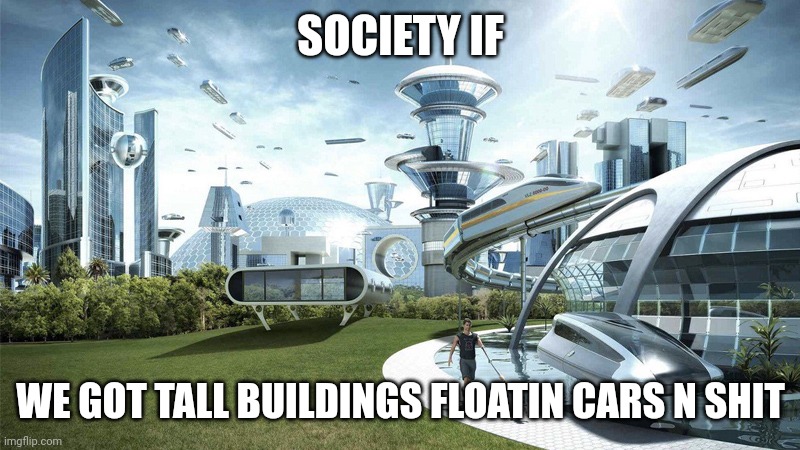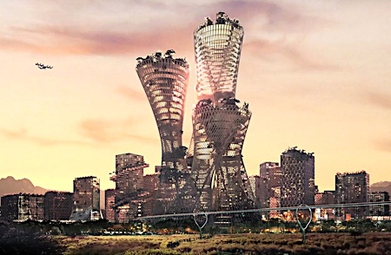anti-Fresco future visions
"society if ..." whatever whatever. you likely have seen the meme, and the image the text is laid upon.

these kinds of visions are very reminiscent of Jacque Fresco's work, which tries to visualize the future. For example:

( from the Venus Project website )
they always kind of stunk to me. The reason is, these kind of future-utopian-cities always seem to be illustrated in a way that implies master planning over a large scale. The buildings are architecturally of the same species, and are arranged around large grids, circles, (etc) of infrastructure. Cities that grow organically and incrementally tend to be jumbled and manifest inconveniences and work-arounds for those inconveniences.
so due to this implied master planning:
these three things have Problems in my opinion.
- a large clear area is needed to fit all this
- cohesion is enforced on said area
- there doesn't seem to be much regard for where this is supposed to take place
1. a large clear area is needed to fit all this.
so where did this large clear area come from, exactly? Was this city built on "undeveloped" land, e.g. land that was cultivated for subsistence, or perhaps served as a home for species that don't mix well with humans? The land we're in desperate shortage of? That land?
Well maybe this large clear area was built up in a place that was already a city. To achieve this, the city that was already there must be destroyed. This can happen as the consequence of another process, as it has in some parts of Europe, where city blocks were taken out by bombs in WWII. but we shouldn't hope for bombs. without bombs, instead it would be bulldozers. Such annihilation of what-was-there has indeed taken place, for example in Paris, replacing much of the crowded — and richly alive — poorer-areas with boulevards and the Pompidou. As Andy Merrifield references in The New Urban Question, this process is an assassination of the urban fabric, by what Guy Debord knew as a "fatal illness". The thing about bulldozing an existing city to make way for a new one is that people already live there, there is history there, there are buildings already standing, resources already spent. so if it isn't built on "empty" land, these utopias are reeking of gentrification and dispossession. Maybe the people already living in these areas would prefer if the existing infrastructure was improved upon, that they could have a better life without being evicted? Maybe they'd like a say in what improvements would suit the place best?
2. cohesion is enforced on said area.
that leads me into my second concern. These "utopias" are aesthetically cohesive over their large scale. Cities are incredibly densely populated with a huge variety of people, & it would take a lot of well-facilitated discussion to even repair and add-on-to one single block of flats in a way all the residents consider fair. On a city-scale, you'd expect immense heterogeneity as places shape to suit their inhabitants. This is not apparent in these future-cities. Which beg the questions: whose ideas got heard, whose didn't, and why were some heard and not others?
In our current context, the answer is money. The only people with the means to scrape a bit of land clean of whatever-was-there and build a whole new city are the super-rich. If their city doesn't suit your needs and wants, tough luck.
but even when taking Fresco's concept of a money-free society forward, the homogeneity remains. So something still gave one vision precedent over the others. It is deeply sinister.
3. there doesn't seem to be much regard for where this is supposed to take place.
The lack of what-used-to-be-there fundamentally detaches these cities from their context. This is compounded by little-to-no influence of the context in the architecture ... not even in homage does the culture of the area remain. This is in stark contrast to movements such as Afrofuturism which center a cultural context.
Then there is the ecological context. A city in the desert will have to be different to one in a temperate area, in the tropics, nearing the Arctic circle. Shoving the same design into different ecologies is bound to send the demand for heating, cooling, (etc) into the stratosphere.
...
basically I think a chunk of people took inspiration from futurist visions like Fresco's in a deeply cynical way, often latching on to the master-built aesthetic "of the future" without considering the focuses of sustainability and equity that Fresco incorporated into his designs (successfully or not). The large-scale nature of the ideas make them out-of-reach to all but the super-rich, making ideas like "sustainability" and "just having a nice place to live" feel increasingly impossible for most of us. Meanwhile, as we are deprived of the capacity to assert our own visions, those with the money to do so aim to create profoundly out-of-touch cities and arcologies like Telosa and Neom (aka "the line").

( a very small rendering of Telosa from the Wikipedia article ).
...because really, who jumps at the opportunity for forcing an entire city to conform to a vision, except those who are thrilled at having hundreds of thousands under their thumb? The "society if ..." city is for them. It is almost certainly not for the rest of us.
...
thanks for reading!🪱🦀
Atom feed ; RSS feed
check out my reading list while you're here :)